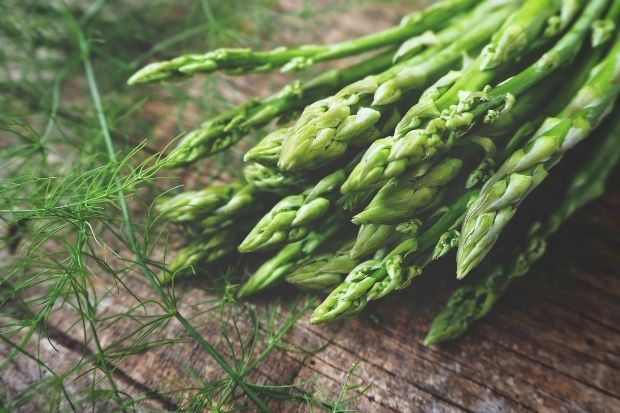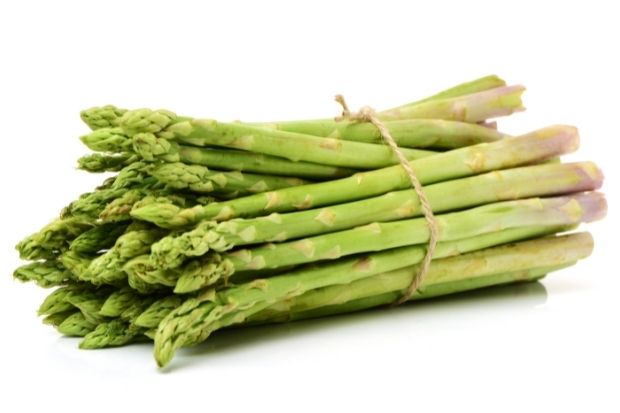Asparagus is a delicious vegetable with numerous health benefits, but if you’ve never had it before, you might be wondering what parts you should eat and what parts you should avoid.
You can eat all parts of asparagus with the exception of the stem (sometimes called the “end”) at the base of the asparagus, which can be a little tough and can have an unpleasant taste. The base or stem of the asparagus won’t hurt you, but it also won’t taste very good.

Parts of the Asparagus
Asparagus has a beautiful green color and has three main parts: the stem (base), the spear, and the tip. While you can technically eat the entire vegetable, most people find the woody stems of the asparagus to be somewhat tough and to have an unpleasant flavor. Let’s take a further look at what parts of the asparagus are edible and which ones aren’t:
Edible Parts of Asparagus
The spear and the tip of the asparagus are completely edible and delicious. The tips are also called immature shoots, and the spears are usually covered with tough fibers. These fibers can be removed with a knife or vegetable peeler.
Non-Edible Parts of Asparagus
You’ll want to avoid the stem of the asparagus. In fact, you can get rid of the inedible stem simply by snapping or cutting off the bottom two inches of the fresh asparagus.
Why You Shouldn’t Eat the Bottom of Asparagus
While you technically can eat the bottom or stems of asparagus, they tend to be very tough and have a bitter taste, which is why most people cut them off and discard them. But you can save the stems and use them in certain recipes, such as for a delicious soup.

How To Trim Asparagus: A Simple Method
Trimming asparagus is a breeze. It’s important to trim the vegetable before you cook it or eat it raw. Follow these steps to trim the asparagus and get your asparagus spears ready for your next dish:
- Take the first asparagus and hold it with the thumb and forefinger of each hand. Gently bend the asparagus until it snaps. You’ll notice that it usually snaps right at the location of the stem, so the asparagus stem will instantly be removed.
- Take that asparagus and line it up with the remaining spears, making sure the tips are all even with one another.
- With a knife, remove the stems of the remaining spears, cutting off the same amount of stem on the remaining spears as you removed on the very first one.
- After you’re done, all your asparagus pieces should be lined up perfectly in a nice, even row.
Asparagus can also be scrubbed with a vegetable cleaning brush, either before or after you trim the spears. You’ll notice that most of these spears are quite long, so even when you cut off the two-inch stems, you’ll still have plenty of asparagus to enjoy.
Does Asparagus Need To Be Peeled?
You do not have to peel asparagus, but peeling it will make the spears more tender and juicy—and the vegetables will be a lot prettier. The spears themselves can have what look like scale leaves on them, and those are not very attractive. When asparagus spears are peeled, their light-green, almost white color is revealed, and the veggie looks smoother.
You can check if your asparagus should be peeled by sampling a small piece from the bottom (after you’ve already cut off the stem). If the piece is tough, it’s a good idea to peel the spears.
If you’d rather skip the taste test, you can follow an alternative rule: Asparagus that is 1/2 inch or larger in diameter should be peeled. The bigger the piece, the tougher it generally is. Peeling the bigger spears will make them a lot less tough, which means they’ll cook faster and be more tender after they’re cooked.
How To Peel Asparagus
- Clean and trim your spears.
- Place one spear on a flat surface—preferably a cutting board—with the tip hanging over the edge.
- Hold the tip and, using a vegetable peeler or sharp paring knife, slice off the “skin,” starting from just below the tip all the way to the end. Use the tip to rotate the spear as you slice. Only remove a thin layer. You’ll notice a smoother texture and a lighter appearance.
- Repeat for each spear, one at a time.
Quick FAQs: Frequently Asked Questions About Asparagus
Can You Eat Asparagus Stems?
Yes, you can eat asparagus stems, but they likely won’t taste good and will be a little tough.
How Much Stem Do You Cut Off the Asparagus?
Cut off roughly two inches of the base of the asparagus.
Can You Eat Asparagus Without Peeling It?
Yes, you can eat asparagus without peeling it. But if your asparagus is 1/2 inch or larger in diameter, or if it feels tough upon a taste test, it’s a good idea to peel it. This ensures your asparagus is nice and tender after it’s cooked.
What Can I Make With the Woody Ends of Asparagus?
The woody ends of asparagus can be used in a tasty asparagus soup, for a stock, or for flavoring sauces.
What Is the Difference Between Asparagus Tips and Asparagus Spears?
The spear is essentially the full length of the asparagus, while the tip is just the top of it. An easy way to remember this is to think of an actual medieval spear: The weapon itself is called a spear, whereas the sharp point is the tip.
